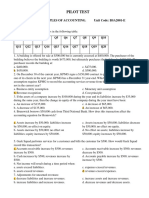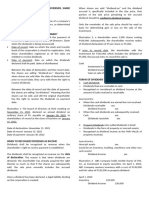Assignment 1
Uploaded by
Ehab HosnyAssignment 1
Uploaded by
Ehab HosnyQuestion 1: Multiple Choice Questions
Question Correct Answer
B) The art of interpreting, measuring, and
1. Which of the following best defines accounting?
communicating financial information.
2. The importance of accounting is all of this, except D) Communicating.
3. Investigation into financial crimes such as fraud
C) Forensic Accounting.
and money laundering
4. The Accounting Assumption is all of this, except D) Materiality.
5. In accounting, which of the following is considered
B) Cash.
an asset?
6. The double-entry system in accounting means that C) Affects at least two accounts, with a debit
each transaction and a credit.
7. Which of the following represents the correct
B) Assets = Liabilities + Equity.
accounting equation?
B) The owner contributes additional capital in
8. Which transaction increases equity?
cash.
10. A business purchases equipment for $5,000 by C) Increase assets by $5,000, increase liabilities
paying $2,000 in cash and taking a loan for the rest. by $3,000, decrease cash by $2,000.
Question 2: True or False
Statement Answer
1. The purpose of accounting is to provide financial information to help in decision-making. True
2. Inventory is an example of an asset. True
3. Expenses are recorded on the left side of the accounting equation. False
4. A credit entry always increases an asset account. False
5. Only assets are reported on the income statement. False
Statement Answer
6. Accrued expenses are recorded when cash is paid in advance for a future expense. False
7. Financial accounting is primarily concerned with providing information for internal users. False
8. The accounting period can be a month, a quarter, or a year. True
9. Accounts payable is an example of a liability. True
Question 3: Transaction Analysis
Transaction Assets Liabilities Equity
1. Owner invests $15,000 cash +$15,000 No change +$15,000
2. Purchase office supplies worth $1,000 -$1,000 No change No change
3. Received $3,000 for services +$3,000 No change +$3,000
4. Paid $500 for rent -$500 No change -$500
5. Owner withdrew $700 -$700 No change -$700
Question 4: Effects of Transactions (Joan Robinson’s Law Office)
Transaction Assets Liabilities Equity
Joan invested $11,000 in cash +$11,000 No change +$11,000
Paid $800 for rent -$800 No change -$800
Purchased office equipment on credit $3,000 +$3,000 +$3,000 No change
Provided legal services for $1,500 cash +$1,500 No change +$1,500
Borrowed $700 cash from a bank +$700 +$700 No change
Performed legal services on account $2,000 +$2,000 No change +$2,000
Transaction Assets Liabilities Equity
Paid monthly expenses of $900 -$900 No change -$900
Joan withdrew $1,000 for personal use -$1,000 No change -$1,000
Question 5: Effects of Transactions (Campus Laundromat)
Transaction Assets Liabilities Equity
Bob invested $20,000 cash +$20,000 No change +$20,000
Paid $1,000 for rent -$1,000 No change -$1,000
Purchased washers and dryers $25,000 +$25,000 +$15,000 -$10,000
Paid $1,200 for insurance -$1,200 No change -$1,200
Advertising bill received: $200 No change +$200 No change
Bob withdrew $700 for personal use -$700 No change -$700
Earned $6,200 from services +$6,200 No change +$6,200
Question 6: Journalizing Ellie Company Transactions
Date Account Debit ($) Credit ($)
Aug 1 Cash 20,000 Capital 20,000
Aug 5 Rent Expense 700 Cash 700
Aug 7 Office Equipment 4,000 Accounts Payable 4,000
Aug 12 Cash 1,500 Revenue 1,500
Aug 15 Salaries Expense 500 Cash 500
Aug 20 Accounts Payable 2,000 Cash 2,000
Aug 25 Accounts Receivable 2,000 Revenue 2,000
Date Account Debit ($) Credit ($)
Aug 30 Withdrawals 500 Cash 500
Question 7: GTS Company
Transaction Debit ($) Credit ($)
March 1: Invested $80,000 cash Cash 80,000 Capital 80,000
March 4: Paid rent $5,000 Rent Expense 5,000 Cash 5,000
March 6: Purchased supplies $4,000 Supplies 4,000 Cash 4,000
March 10: Earned $10,000 Cash 10,000 Revenue 10,000
March 15: Withdrawn $7,500 Withdrawals 7,500 Cash 7,500
Question 8: Adjusting Entries (Stellar Services)
Account Debit ($) Credit ($)
Insurance Expense 3,000 Prepaid Insurance 3,000
Rent Expense 2,700 Prepaid Rent 2,700
Unearned Revenue 1,000 Revenue 1,000
Supplies Expense 2,200 Office Supplies 2,200
Depreciation Expense 3,000 Accumulated Depreciation 3,000
You might also like
- Milestone 1 - Financial Statement AnalysisNo ratings yetMilestone 1 - Financial Statement Analysis10 pages
- The Gone Fishin' Portfolio: Get Wise, Get Wealthy...and Get on With Your LifeFrom EverandThe Gone Fishin' Portfolio: Get Wise, Get Wealthy...and Get on With Your LifeNo ratings yet
- Partnership and Corporation Accounting Quiz Test INo ratings yetPartnership and Corporation Accounting Quiz Test I5 pages
- Objectives, Case Based Que of TS GrewalNo ratings yetObjectives, Case Based Que of TS Grewal42 pages
- CBSE Sample Papers for Class 11 Accountancy Set 3 With SolutionsNo ratings yetCBSE Sample Papers for Class 11 Accountancy Set 3 With Solutions25 pages
- The Accounting Process, Accounting Equation For Business TransactionsNo ratings yetThe Accounting Process, Accounting Equation For Business Transactions23 pages
- CBSE Sample Papers For Class 11 Accountancy Set 2 With SolutionsNo ratings yetCBSE Sample Papers For Class 11 Accountancy Set 2 With Solutions24 pages
- CBSE Class 11 Accountancy Worksheet - Question BankNo ratings yetCBSE Class 11 Accountancy Worksheet - Question Bank17 pages
- CBSE Sample Papers for Class 11 Accountancy Set 2 with SolutionsNo ratings yetCBSE Sample Papers for Class 11 Accountancy Set 2 with Solutions26 pages
- If, Cost of Machine Rs.400, 000 Useful Life 5 Years Rate of Depreciation 40%No ratings yetIf, Cost of Machine Rs.400, 000 Useful Life 5 Years Rate of Depreciation 40%13 pages
- 2021 Year Question Paper Solution AccountsNo ratings yet2021 Year Question Paper Solution Accounts27 pages
- Fundamental of Accounting I Model Exam @2016No ratings yetFundamental of Accounting I Model Exam @201615 pages
- Your Net Worth Should Increase 10% Annually: Or You Risk Falling Behind: Financial Freedom, #283From EverandYour Net Worth Should Increase 10% Annually: Or You Risk Falling Behind: Financial Freedom, #283No ratings yet
- The Barrington Guide to Property Management Accounting: The Definitive Guide for Property Owners, Managers, Accountants, and Bookkeepers to ThriveFrom EverandThe Barrington Guide to Property Management Accounting: The Definitive Guide for Property Owners, Managers, Accountants, and Bookkeepers to ThriveNo ratings yet
- Percentage Change in Quantity - High Price Elasticity Indicate That The Quantity Demanded Varies So Much As Price Change and Vice VersaNo ratings yetPercentage Change in Quantity - High Price Elasticity Indicate That The Quantity Demanded Varies So Much As Price Change and Vice Versa3 pages
- Assignment One: The Old and New Role of Central BanksNo ratings yetAssignment One: The Old and New Role of Central Banks4 pages
- Money and Banking 1: Dr. Rania Ramadan MoawadNo ratings yetMoney and Banking 1: Dr. Rania Ramadan Moawad11 pages
- Student Name:: Badm New Cairo Business Finance 1 Summer 2019/2020 50No ratings yetStudent Name:: Badm New Cairo Business Finance 1 Summer 2019/2020 507 pages
- Money and Banking 1: Dr. Rania Ramadan MoawadNo ratings yetMoney and Banking 1: Dr. Rania Ramadan Moawad16 pages
- Importance of Biology: How The Study of Life Affects Ours: By: Maiar Azmy Hassan Ahmed SakrNo ratings yetImportance of Biology: How The Study of Life Affects Ours: By: Maiar Azmy Hassan Ahmed Sakr5 pages
- Full Download (Ebook) English Grammar & Punctuation by BarCharts, Inc. ISBN 9781572225312, 9781423218654, 1423218655, 1572225319 PDF DOCX100% (3)Full Download (Ebook) English Grammar & Punctuation by BarCharts, Inc. ISBN 9781572225312, 9781423218654, 1423218655, 1572225319 PDF DOCX40 pages
- 1677065485paper 4a - 06. Capital Gain (Cainft-Ad-may23)No ratings yet1677065485paper 4a - 06. Capital Gain (Cainft-Ad-may23)23 pages
- CorpFin - Midterm Notes (Chap - 1,2,3,4,29 and 39)No ratings yetCorpFin - Midterm Notes (Chap - 1,2,3,4,29 and 39)17 pages
- Chapter Four - Class Exercise Problems SolutionsNo ratings yetChapter Four - Class Exercise Problems Solutions2 pages
- Financial Accounting and Analysis - Unit 4 - Week 3 - A Closer Look at The Income Statement, Cash Flow Statement and Statement of Changes in EquityNo ratings yetFinancial Accounting and Analysis - Unit 4 - Week 3 - A Closer Look at The Income Statement, Cash Flow Statement and Statement of Changes in Equity5 pages
- Week 14-15 - Working Capital Exercise 01 - SolutionNo ratings yetWeek 14-15 - Working Capital Exercise 01 - Solution6 pages
- Chapter 16 Equity Investments (Dividends, Share Split, and Share Right)No ratings yetChapter 16 Equity Investments (Dividends, Share Split, and Share Right)5 pages
- UNI 20231025143615092493 960536 uniROC IpayccNo ratings yetUNI 20231025143615092493 960536 uniROC Ipaycc6 pages
- Account Overview: View History For Transaction History PeriodNo ratings yetAccount Overview: View History For Transaction History Period6 pages
- The Gone Fishin' Portfolio: Get Wise, Get Wealthy...and Get on With Your LifeFrom EverandThe Gone Fishin' Portfolio: Get Wise, Get Wealthy...and Get on With Your Life
- Partnership and Corporation Accounting Quiz Test IPartnership and Corporation Accounting Quiz Test I
- CBSE Sample Papers for Class 11 Accountancy Set 3 With SolutionsCBSE Sample Papers for Class 11 Accountancy Set 3 With Solutions
- The Accounting Process, Accounting Equation For Business TransactionsThe Accounting Process, Accounting Equation For Business Transactions
- CBSE Sample Papers For Class 11 Accountancy Set 2 With SolutionsCBSE Sample Papers For Class 11 Accountancy Set 2 With Solutions
- CBSE Class 11 Accountancy Worksheet - Question BankCBSE Class 11 Accountancy Worksheet - Question Bank
- CBSE Sample Papers for Class 11 Accountancy Set 2 with SolutionsCBSE Sample Papers for Class 11 Accountancy Set 2 with Solutions
- If, Cost of Machine Rs.400, 000 Useful Life 5 Years Rate of Depreciation 40%If, Cost of Machine Rs.400, 000 Useful Life 5 Years Rate of Depreciation 40%
- Your Net Worth Should Increase 10% Annually: Or You Risk Falling Behind: Financial Freedom, #283From EverandYour Net Worth Should Increase 10% Annually: Or You Risk Falling Behind: Financial Freedom, #283
- The Barrington Guide to Property Management Accounting: The Definitive Guide for Property Owners, Managers, Accountants, and Bookkeepers to ThriveFrom EverandThe Barrington Guide to Property Management Accounting: The Definitive Guide for Property Owners, Managers, Accountants, and Bookkeepers to Thrive
- Percentage Change in Quantity - High Price Elasticity Indicate That The Quantity Demanded Varies So Much As Price Change and Vice VersaPercentage Change in Quantity - High Price Elasticity Indicate That The Quantity Demanded Varies So Much As Price Change and Vice Versa
- Assignment One: The Old and New Role of Central BanksAssignment One: The Old and New Role of Central Banks
- Student Name:: Badm New Cairo Business Finance 1 Summer 2019/2020 50Student Name:: Badm New Cairo Business Finance 1 Summer 2019/2020 50
- Importance of Biology: How The Study of Life Affects Ours: By: Maiar Azmy Hassan Ahmed SakrImportance of Biology: How The Study of Life Affects Ours: By: Maiar Azmy Hassan Ahmed Sakr
- Full Download (Ebook) English Grammar & Punctuation by BarCharts, Inc. ISBN 9781572225312, 9781423218654, 1423218655, 1572225319 PDF DOCXFull Download (Ebook) English Grammar & Punctuation by BarCharts, Inc. ISBN 9781572225312, 9781423218654, 1423218655, 1572225319 PDF DOCX
- 1677065485paper 4a - 06. Capital Gain (Cainft-Ad-may23)1677065485paper 4a - 06. Capital Gain (Cainft-Ad-may23)
- CorpFin - Midterm Notes (Chap - 1,2,3,4,29 and 39)CorpFin - Midterm Notes (Chap - 1,2,3,4,29 and 39)
- Financial Accounting and Analysis - Unit 4 - Week 3 - A Closer Look at The Income Statement, Cash Flow Statement and Statement of Changes in EquityFinancial Accounting and Analysis - Unit 4 - Week 3 - A Closer Look at The Income Statement, Cash Flow Statement and Statement of Changes in Equity
- Week 14-15 - Working Capital Exercise 01 - SolutionWeek 14-15 - Working Capital Exercise 01 - Solution
- Chapter 16 Equity Investments (Dividends, Share Split, and Share Right)Chapter 16 Equity Investments (Dividends, Share Split, and Share Right)
- Account Overview: View History For Transaction History PeriodAccount Overview: View History For Transaction History Period





































































































